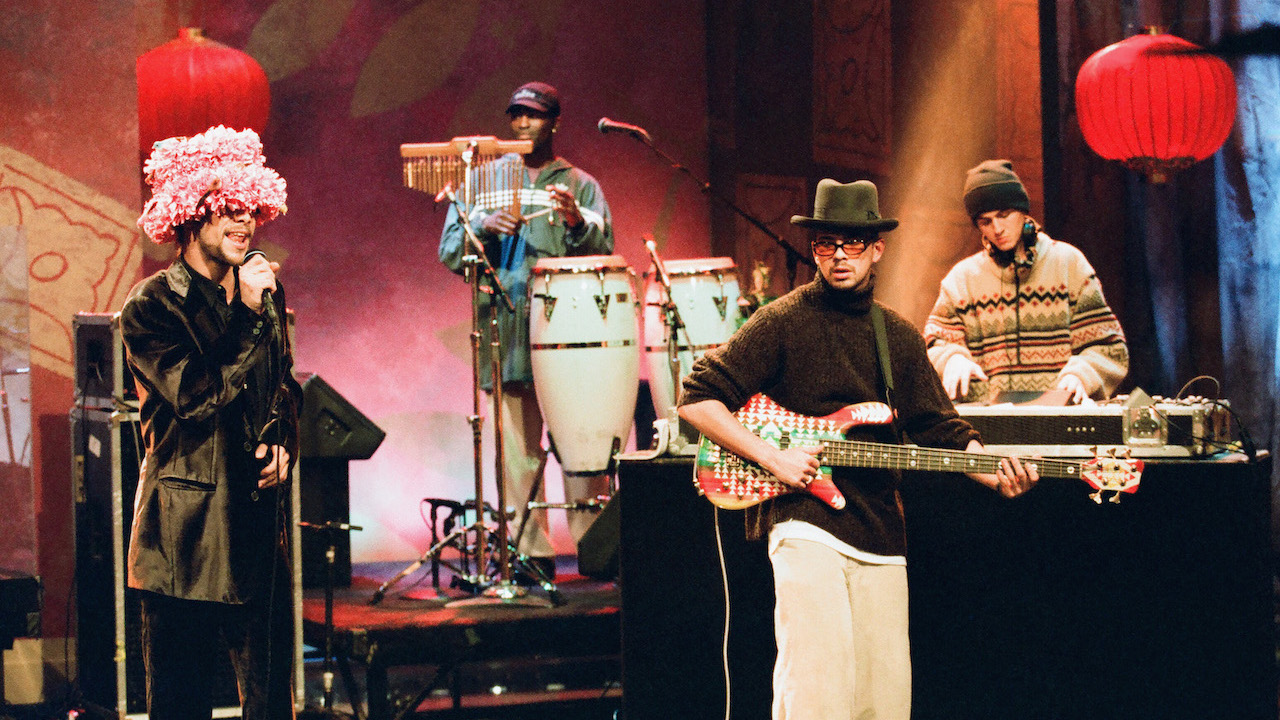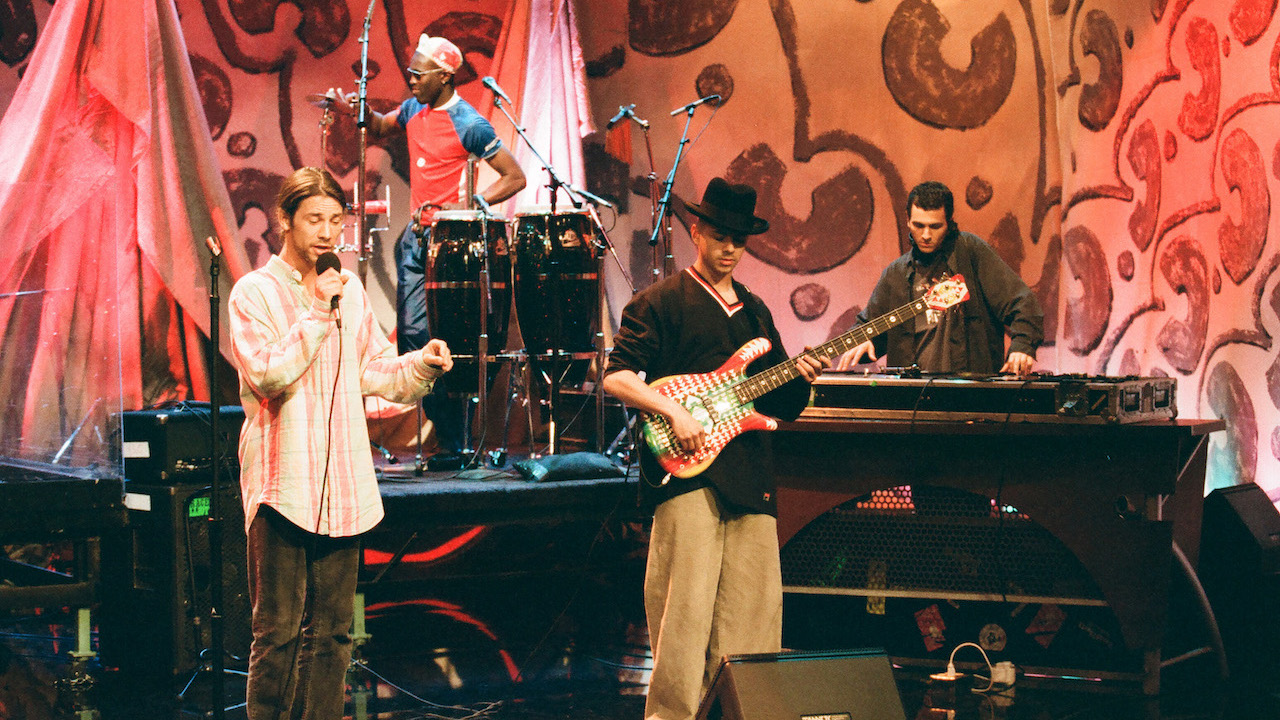“This was one occasion where employing fills and chops in a funk tune really paid off”: Listen to Stuart Zender’s isolated bassline on Jamiroquai's Virtual Insanity
Stuart Zender made an audacious statement with this killer bassline from Jamiroquai’s Traveling Without Moving

For all the times music fans and musicians alike bemoan the lack of musical depth in chart-topping tunes, it’s worth noting the happy exceptions to that perception. One such time was in 1997, when an eclectic group of young British funk disciples called Jamiroquai broke through with an international smash hit.
Driven by jazzy piano chords, a cool-as-ice frontman vocal track, and a super-swinging rhythm section, the song Virtual Insanity swept the MTV video music awards (who can forget the groundbreaking “moving white floor in the hallway” video?), the album Traveling Without Moving went platinum and triple platinum in the U.S. and U.K. respectively, and Jamiroquai brought its version of uncompromisingly rich, jazzy, funky pop music to the masses.
The bassline, a virtuosic opus of both slap and fingerstyle funk, was played by the band’s original bassist, the U.K.-born but Philadelphia-bred Stuart Zender. He was only 22 when he cut the track, and you can hear his youthful enthusiasm sprinkled all over the bassline; this was one occasion where employing fills and chops in a funk tune really paid off.
After laying out for the first verse, Zender comes flying in with an 18th-fret flurry before launching the chorus groove. “I left the beginning empty,” Zender told Bass Player. “I thought the bass would have more of an impact coming in on the chorus. I slapped and used a lot of dampened triplets and glissandos for fills. Some people thought it was the bass drum, but it was actually the bass guitar.”
The bassline (we’re in Eb minor) kicks off with a slap octave under B major, then swings to a Bb7 with a D in the bass. Zender anticipates that chord with an Ab 16th-note at the end of beat two, which sets up his Bb major arpeggio lick on the next beat. That lick ends on D, employing a nice upward-leading motion into the tune’s root chord, Ebm7.
The ascent continues with a new chord on every quarter-note: Gb, Abm, and Ebm/Bb. Zender plays a catchy, octave-driven slap-funk pattern underneath the climb and hits the final chord on the second 15th-note of beat four: there’s your packed dance floor, ladies and gentlemen.
The tune’s mix is a little murky in spots, and while the groove never stops, a close listen leaves you wishing they left more sonic room for Zender's ghost-note articulations.
Get The Pick Newsletter
All the latest guitar news, interviews, lessons, reviews, deals and more, direct to your inbox!
You can listen to the isolated bass and drums below.
Zender gives his thumb a rest for the verse, digging in with his fingers and locking in with the bass drum through the cyclical chord structure. The bar phrasing is key here, as you essentially have a three-bar pattern with a bar of 2/4 tacked onto the end as a turnaround.
The first two of the three full bars go from Ebm7 to Ab7, and the phrase continues on the cycle-of-5ths path to Db7 and Gb6, before the harmonic turnaround, with Cdim and Bmaj7 splitting the bar and pointing down to the Bb augmented chord in the 2/4 bar.
Through all this Zender keeps it pretty simple, using octaves and chromatically climbing into the second chord, and not giving away the cut-bar’s metric shift. The overall result is a slick groove that never seems to resolve itself until the chorus comes around again.
That’s the whole song right there: verse and chorus, two different chord structures, two different basslines, one fingerstyle and one slapped. But as the song progresses, Zender starts throwing in signature licks and fills, forever stamping the tune as his own.
It’s hard to imagine an older session cat going for some of the heavy lumber that he lays down in the final chorus. But his thoughtful application of techniques speaks volumes about the timeless nature of his groove.
“We all used to jam in a room, and this tune was one of those jams. Like a lot of the basslines I came up with, it was the first thing that came into my head. The first thing is usually the right thing.”
Zender plays Warwick basses, and you can hear the thick, super-woody tone of his 5-string whether he’s using his fingers or his thumb. “I used a Warwick Streamer Stage I with MEC pickups. The bass was recorded direct, and I also had a Mesa/Boogie 4x10 with various mics on it.”

Though Jamiroquai enthusiasts were already hip to him, Virtual Insanity widely cemented Zender’s credentials as a young funk pioneer from that day forward. Anyone who checks out the funk he brought to this tune can certainly see why.
One final note for those who know the tune: that slap-sounding fill at the end of the breakdown is actually a guitar.
Chris Jisi was Contributing Editor, Senior Contributing Editor, and Editor In Chief on Bass Player 1989-2018. He is the author of Brave New Bass, a compilation of interviews with bass players like Marcus Miller, Flea, Will Lee, Tony Levin, Jeff Berlin, Les Claypool and more, and The Fretless Bass, with insight from over 25 masters including Tony Levin, Marcus Miller, Gary Willis, Richard Bona, Jimmy Haslip, and Percy Jones.
“I asked him to get me four bass strings because I only had a $29 guitar from Sears”: Bootsy Collins is one of the all-time bass greats, but he started out on guitar. Here’s the sole reason why he switched
“I got that bass for $50 off this coke dealer. I don’t know what Jaco did to it, but he totally messed up the insides!” How Cro-Mags’ Harley Flanagan went from buying a Jaco Pastorius bass on the street to fronting one of hardcore’s most influential bands












